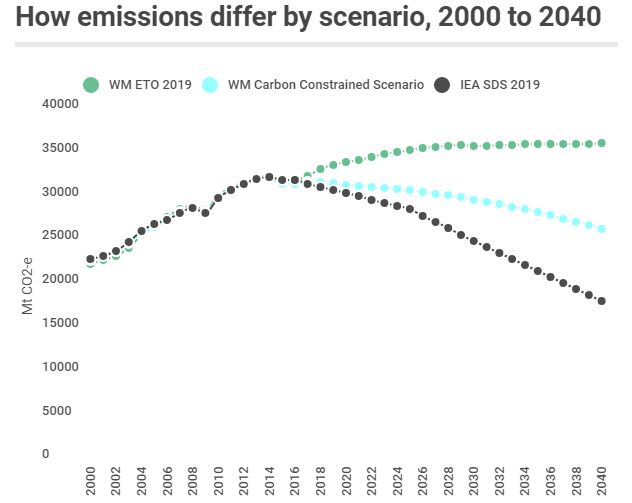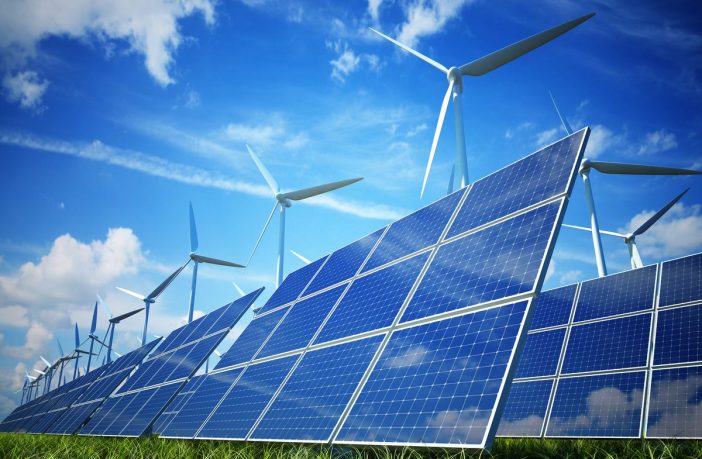Opinion
What hope is there of arresting global warming?
Minimal at the current glacial rate of progress. That’s the depressing conclusion of our latest Energy Transition Outlook (ETO), an exhaustive, bottom-up analysis of global energy demand over the next two decades. The bottom line is that global carbon emissions fall woefully short of the 2°C path or lower spelled out in the 2015 Paris Agreement. Our ETO team – Jonny Sultoon, Prakash Sharma and David Brown – foresees an outcome closer to 3°C by 2040, a scenario that implies a world of escalating climate challenges.

Source: Wood Mackenzie Energy Transition Outlook
Lets start with the good news
The power sector is already being transformed, with renewables on an explosive growth path, propelled by the precipitous fall in wind and solar costs. Renewables’ share of the global power market rises from 7% today to 25% by 2040. Some markets are also looking to build in grid-edge technologies such as energy storage and EV charging.
Transportation, too, is moving – albeit more slowly – in the right direction, spurred by improving battery technology and falling costs. EV sales will exceed 300 million by 2040, 17% of the global light vehicle market compared with under 1% today. Automakers the world over are scrambling to get EVs into their product range to meet welling customer appetite.
Now the bad news
These breakthroughs only modestly dent the upward path of carbon emissions. Zero-carbon energy will contribute just 15% to energy demand by 2040. Fossil fuels make up the other 85%.
So while power and transport may be on the right track, other sectors are not even in the race yet. Aviation, shipping, steel, cement and heating contribute almost 50% of global emissions. These look harder to decarbonise.
What’s more, population and GDP growth will create more wealth, feeding a consumerism that’s already unbridled. A growing number of people will want to spend more beyond basics like food and fuel for heating and cooking – splashing their cash on technology and mobility, goods and materials and driving energy demand up further.
Coal, oil and gas – cost-competitive in the absence of a carbon price – are in pole position to dominate the future fuel mix to meet this demand. Bolstered by the vested interests of governments, producers and, indeed, consumers, fossil fuels can readily tap into the legacy infrastructure and supply chains which support the global economy.
So how to kick the hydrocarbon habit?
First, we need effective policy
Global carbon pricing has to be at the top of the agenda. Today, only 30% of global emissions are priced for carbon. The UK government showed how carbon pricing can work. The carbon price floor imposed has all but killed off coal in the power sector in a few short years.
Demand-side measures will be important, too. Subsidies, tax breaks and perks such as free parking and access to low emissions zones have helped EVs gain traction where they have been tried.
A combination of supply- and demand-side policy can change consumer choices and behaviour by pricing goods and services appropriately. It can also accelerate change in corporate strategies. But until the US is back in the Paris Agreement, any multi-lateral global agreement on carbon tax is a pipe dream.
Secondly, we need more zero-carbon technologies
Carbon capture and storage (CCS) should be a central plank of the energy transition, enabling fossil fuels to support economic growth into the future with lower emissions. But CCS is not yet commercial – projects need a carbon price of up to US$100/tonne to make money, four times the current traded price. Green hydrogen – stripping hydrogen from water using zero-carbon power – is another technology that needs more R&D. Reforestation – carbon sinks – also have a big role to play.
Third, we need investment, a lot of it
Scalability is a major challenge all through the energy value chain. The transition will be costly, from the ramp-up in renewables to the decarbonisation of consumer sectors. We estimate it will cost US$4.5 trillion over 20 years to decarbonise the US power grid, a staggering US$35,000 per household.
The crux is that without the policy, it’s difficult to see the investment materialising. And without the investment, a 3°C trajectory is the more likely outcome than 2°C.
Author: Simon Flowers, Chairman and Chief Analyst at Wood Mackenzie















